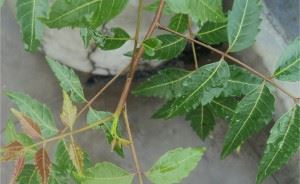Plants are an essential part of the ecosystem. Every life on the earth is directly or indirectly dependent on plants. Among the different parts of a plant, the leaf is the most essential.
Primarily, leaves have two functions: photosynthesis and transpiration. In some plants, it takes up the responsibility of reproduction also.
Table of Contents
Let’s learn more about the morphology of leaves, parts of a leaf, different types of leaves and their modifications.
Structure of a Leaf
Leaves are thin, flat organs responsible for photosynthesis in the plants. It develops laterally at the node. It is an important part of the shoot system and it originates from shoot apical meristems.
The structure of a leaf is described below in detail :
Parts of a Leaf
Generally, leaf base, petiole, and lamina, together form the main parts of a leaf.
- Leaf Base: This is the part where a leaf attaches to the stem. Leaf base has two small leaf-like structure called stipules. In plants like paddy, wheat, and other monocotyledons, this leaf base is wide and masks the stem.
- Petiole: Petiole is the long, thin, stalk that links the leaf blade to the stem.
- Lamina: Also known as leaf blade. It is the green, flat surface of the leaves. It consists of a small branched vein and veinlets. The vein that runs along the middle of the lamina is called midrib. Midrib divides the surface of the lamina into two. These veins and veinlets give rigidity to the leaf blade and help in the transportation of water and other substances.

A leaf diagram representing the parts of a leaf
Venation
Venation is defined as the arrangement of veins and the veinlets in the leaves. Different plants show different types of venation. Generally, there are two types of venation:
- Reticulate venation: In a reticulate venation, the veinlets are randomly arranged and form a complex network of veinlets. Ex: Dicotyledonous plants like a rose plant.

Reticulate venation
- Parallel venation: In a parallel venation, the veinlets run parallel to each other. Ex: In monocotyledons like paddy.

Parallel venation
Also Read: Root Modifications
Recommended Video:

Types of Leaves
There are two broad categories of leaves – simple and compound, which are further classified into different groups based on their shape, size, their arrangements on the stem, leaves of flowering and non-flowering plants, and various other physical attributes.
The two different types of leaves found in a plant are:
Simple Leaf
When a single lamina is connected to the main stem by a petiole, the leaf is said to be simple. A simple leaf may be incised to any depth but not down to the midrib or petiole. Eg., Guava leaves
Compound Leaf
A compound leaf is a leaf made up of two or more leaflets. In a compound leaf, the midrib of the leaf is branched into different leaflets and is connected by a single petiole. For eg., Pea, palm leaves.

The compound leaves are further sub-divided into the following types of leaves:
Palmately Compound Leaf
In a palmately compound leaf, the leaflets are attached at the tip of the petiole. Eg., Silk cotton. These can be differentiated into:
- Unifoliate: These type of leaves have only one leaflet. Eg., Citrus
- Bifoliate: These leaves have two leaflets. Eg., Balanites
- Trifoliate: These leaves have three leaflets emerging from the same point. Eg., Oxalis
- Quadrifoliate: These leaves have four leaflets arising from the same point. Eg., Marsilea
- Multifoliate: This type of leaf has many leaflets arising at a common pint. Eg., Bombax
Pinnately Compound Leaf
In a pinnately compound leaf, the midrib of the leaf is divided into numerous leaflets and all connected by a common axis. Eg., Neem. These can be further differentiated into:
- Pinnate: A compound leaf that has an axis on each side of the midrib is known as a pinnate leaf.
- Unipinnate: The leaf with leaflets on each side of the axis. Eg., cassia
- Bipinnate: Here, a secondary axis bearing the leaflet is produced by the central axis. Eg., Acacia
- Tripinnate: Here, a tertiary axis bearing leaflets emerges from the secondary axis. Eg., Moringa
- Decompound: Leaf with more than three pinnate. Eg., old leaves of coriander
- Parapinnate: A leaf without a terminal leaflet. Eg., Cassia
- Imparipinnate: Leaf with an odd terminal leaflet. Eg., Pea

Palmately compound leaf & Pinnately compound leaf
Phyllotaxy
The patterns of arrangement of leaves on the stem are called Phyllotaxy. Plants show three types of phyllotaxy- alternate, opposite and whorled types of phyllotaxy.
- When only a single leaf develops at each node alternatively, it is an alternate type of phyllotaxy.E.g. China rose.
- When a pair of leaves develops at each node opposite to each other, it is called opposite phyllotaxy.E.g. Guava plants.
- When more than two leaves develop at the nodes to form a whorl of leaves, it is called whorled phyllotaxy. E.g. Alstonia.
Also Read: Transportation in Plants
Modification Of Leaves
We know leaves are specialised to perform photosynthesis. In addition, they also have other significant roles to play, such as support, storage of food, defence, etc. For each of these functions, they have been modified into different forms.
For example, tendrils of peas, spines of cacti, onion bulb, leaves of insectivorous plants, etc. are different modified leaves. Let us have a detailed look at some of the modification of leaves:
Storage Leaves
The xerophytic plants and plants belonging to the Crassulaceae family have thick and succulent leaves that store water in their tissues. The parenchymatous cells of these leaves have large vacuoles filled with hydrophilic colloid. This modification helps the plant to resist desiccation.
Leaf Tendrils
Leaf tendrils exist in plants with weak stems. The leaves get modified into thread-like structures called tendrils. These tendrils climb a nearby stick or wall and provide support to the plant. For eg., In Lathyrus aphaca, the whole leaf is modified into tendrils. The upper leaflets of Pisum sativum get modified into tendrils.
Leaf Spines
A few plants have their leaves modified into needle-like structures known as spines. The spines act as defensive structures. They also reduce water loss due to transpiration. For eg., in Opuntia, the leaves are modified into spines.
Scale Leaves
These are thin, membranous structures, without stalks, brownish or colourless in appearance. They protect the auxiliary bud present in their axil. Scale leaves in onion are fleshy and thick and store food and water. Casuarina and Asparagus also contain sale leaves
Leaflet Hooks
In some plants, the terminal leaflets of leaf get modified into hook-like structures that help them in climbing. Eg., Bignonia unguiscati.
Leaf Roots
In a few plants, one of the leaves present at the nodes gets modified into adventitious roots which helps them to float over the water surface. Eg., Salvinia
Phyllode
In some plants, the petiole becomes flattened, taking the shape of a leaf and turns green in colour. This is known as phyllode. For eg., Australian Acacia.
Insectivorous Leaves
Few plants require nitrogen for their development. In such plants, the leaves are modified to catch and digest insects. Few of the modifications are mentioned below:
- Leaf Pitcher- In a few plants like Nepenthes, the leaf-lamina is modified into a pitcher-like structure. The insect is digested into the inner walls of the pitcher which secretes a digestive fluid into the pitcher cavity.
- Leaf Bladder- In such plants, the segments of the leaves are modified into bladders. These plants are found in water. The inner wall is provided with digestive glands which helps in digesting the trapped insect. For eg., Utricularia
- In Drosera– The lamina possesses numerous hair with a sticky globule at its tip containing digestive enzymes. The moment an insect sits on the lamina, the hair covers the insect completely.
Functions of Leaves
The leaves perform the following functions:
Photosynthesis
Photosynthesis is the primary function of leaves. They convert carbon dioxide, water, and UV light into glucose through the process of photosynthesis.
Also Refer: Photosynthesis
Transpiration
Transpiration is the removal of excess water from the plants into the atmosphere. This occurs by the opening of stomata present in the leaves.
Guttation
Removal of excess water from the xylem at the edges of the leaves when the stomata are closed is known as guttation.
Storage
Leaves are a site of photosynthesis. Therefore, they store water and nutrients. The succulent and thick leaves particularly adapt to water storage.
Defence
Some leaves are modified into spines to protect them from being damaged or eaten by animals. For eg., Opuntia.
Key Points
- Leaves are found at the nodes of the stem and contain the photosynthetic pigment chlorophyll.
- There are three main parts of a leaf – Leaf base, leaf lamina, and petiole.
- There are two different types of leaves – simples leaves and compound leaves. The other types of leaves include acicular, linear, lanceolate, orbicular, elliptical, oblique, centric cordate, etc.
- They perform the function of photosynthesis and help in the removal of excess water from the aerial parts of the plant.
- They are modified in the form of spines, tendrils, hooks and scales and help them to adapt to various environments.
Also Read: Guttation
For more information on Morphology of Leaves, different types of leaves, parts of a leaf, its modifications, structure and functions, keep visiting BYJU’S website or download BYJU’S app for further reference.
Frequently Asked Questions
What do you mean by the morphology of leaves?
Morphology is the study of science that deals with the form and structure of an organism. Morphology of leaves deals with the study of the structural features and parts of a leaf.
What are the different types of leaves?
There are two different types of leaves – simple and compound leaves. Simple leaves are lobed or divided but do not form distinct leaflets. Whereas, in a compound leaf the leaves are divided into distinct leaflets and each leaflet has a small petiole.
What is the most important function of the leaves?
Photosynthesis is the major function performed by leaves. They convert carbon dioxide, water and sunlight into glucose and energy.
How are the veins of the leaves important?
The veins of the leaves are provided with vascular tissues called xylem and phloem. Xylem transports water from the roots to the leaves whereas phloem transports food through the leaf to rest of the plant.
Why are leaves a major part of the plant?
Leaves are the main source of photosynthesis, the process by which the plants feed themselves. They also help to transport water and food to different parts of the plant. Thus they play a major role in the survival of a plant. Besides, they also help in the exchange of gases by the opening and closing of stomata and removes excess water from the plant by the process of transpiration.
What are the different shapes of the leaves?
There are various types of leaves, each with its own shapes. These shapes range from oval, elliptical and linear, to truncate and lanceolate.
What is wilting?
Wilting is the drying out, withering and drooping of leaves of a plant due to insufficient water supply, excessive transpiration or some vascular disease.
What is the different modification of leaves?
Leaves can be modified in the form of spines that reduce water loss and also act as a defence. Some are modified into tendrils to provide support to the plant. Some leaves are thick that help in water storage. Some are modified to catch and digest insects.



I love byjus
I love byjus
I also love byjus
How can we understand which is simple leaf and which is Compound leave?